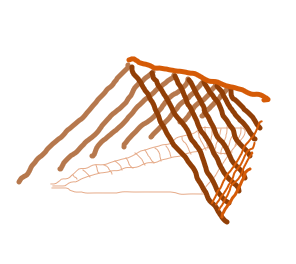
 5
5




 1
1




 4
4




 2
2




A human being should be able to change a diaper, plan an invasion, butcher a hog, conn a ship, design a building, write a sonnet, balance accounts, build a wall, set a bone, comfort the dying, take orders, give orders, cooperate, act alone, solve equations, analyze a new problem, pitch manure, program a computer, cook a tasty meal, fight efficiently, die gallantly. Specialization is for insects.
-Robert A. Heinlein
 2
2




That sounds to me as if the end of the single ridge beam will be resting on the ground at the back of the structure. Is that what you mean? Having the ridge beam sloped towards the back makes a lot of sense, but having it supported on a shorter BFL before ground level (maybe 4 or 6 feet up depending on how high the front one is) would seem to me to give you more usable space. If that's a "person" standing in the window in the drawing, that suggests to me that the single post is in the order of 12 feet tall.The idea is it's a single post and single ridge beam, both made of BFL's (big fuckin' logs).
Visit Redhawk's soil series: https://permies.com/wiki/redhawk-soil
How permies.com works: https://permies.com/wiki/34193/permies-works-links-threads
 2
2




"You must be the change you want to see in the world." "First they ignore you, then they laugh at you, then they fight you, then you win." --Mahatma Gandhi
"Preach the Gospel always, and if necessary, use words." --Francis of Assisi.
"Family farms work when the whole family works the farm." -- Adam Klaus

 4
4




"Never doubt that a small group of thoughtful, committed citizens can change the world; indeed, it's the only thing that ever has."-Margaret Mead "The only thing worse than being blind, is having sight but no vision."-Helen Keller
 1
1




You should never forget that every creature has its purpose in the cycle of nature and can also be very important to humans. Sepp Holzer's Permaculture
 1
1




Lorinne Anderson: Specializing in sick, injured, orphaned and problem wildlife for over 20 years.
 2
2




Daniel Ray wrote:There must have been something in the air...
Retire Early w/ this thread: https://permies.com/t/40/101935/HEX-token#1291916
Dehydrator Package: https://permies.com/t/93088f35/Solar-Dehydrator-Plans-Triple-Combo
Davin's website: http://www.davinhoyt.com
#Rich HEX.COM $HEX #HEX $PLS #PLS #HEXcrypto #HEXtoken #ERE #FIRE #BTC #bitcoin
 2
2




Jay Angler wrote:
2. What kind of height are you thinking about - tall enough for a loft? That will solve some of the head room problem on the first floor and sleep's one of those things you don't need to do standing up!
![Filename: worst-photoehop-a-frame-wofati2.jpg
Description: I also have flux on my computer, making everything orange and sleepy, and so I don't even know if the sky is blue, hahahaha! [Thumbnail for worst-photoehop-a-frame-wofati2.jpg]](/t/150481/a/123327/worst-photoehop-a-frame-wofati2.jpg)
 2
2




Exactly! Essentially you're suggesting a below grade level "knee wall" which improves the issue of low height "dead space" which still needs to be cleaned and heated, but may defeat the "almost instant" housing bit.What if the wall extended straight down about 3 feet. If couches and counters lined the walls, you'd never be standing where the wall meets the floor amd bonking your head.
Doing it this way probably is a lot more complex than a simple A frame, though...
Visit Redhawk's soil series: https://permies.com/wiki/redhawk-soil
How permies.com works: https://permies.com/wiki/34193/permies-works-links-threads
 2
2




 6
6




Regards, Scott
 3
3




The holy trinity of wholesomeness: Fred Rogers - be kind to others; Steve Irwin - be kind to animals; Bob Ross - be kind to yourself
 1
1




 1
1




Many things last lifetimes or eons, but the only thing that's permanent is the ever-changing flow itself





 1
1




Hans Albert Quistorff, LMT projects on permies Hans Massage Qberry Farm magnet therapy gmail hquistorff















 1
1




Hans Albert Quistorff, LMT projects on permies Hans Massage Qberry Farm magnet therapy gmail hquistorff
 2
2




William Bronson wrote: I'm realizing just now that I'm not clear about some physical principles of buildings.
Is an A-frame structure better at resisting the weight of bermed earth than a vertical sided structure?
If so, is it it due to the the slope of the soil supporting wall,due to the buttress provided by the opposite wall, both, or something else entirely?




Mostly because an Equilateral triangle is a better approximation of an arch than a square or rectangle.
 9
9




 4
4




 1
1




That is totally adorable! However, judging by the height of the chair, it also demonstrates my point about head-room, despite having closed off and bermed the shortest part of the triangle.William Bronson wrote:So here's a take on the bermed attic truss house:
Visit Redhawk's soil series: https://permies.com/wiki/redhawk-soil
How permies.com works: https://permies.com/wiki/34193/permies-works-links-threads
 1
1




 2
2




William Bronson wrote:
Mostly because an Equilateral triangle is a better approximation of an arch than a square or rectangle.
Would a gambrel roof be closer still?




There are places where the "weight" of the house was all that was used to keep the house on the foundations! This can be a *really* bad idea in areas with tornadoes, hurricanes and earthquakes. Most modern building codes have rules about fastening walls to foundations and roofs to walls and I've learned that I'm often further ahead to build "better than code" due to some of the "gusty, energetic" storms we get. I've got a "temporary" processing shed which is a modified portable car shelter with large spikes holding it down and a guy line at one front corner as there isn't a good place to put a second guy for the other corner. We had an atypical wind direction with big gusts the other night and the spikes are several inches out of the ground. Since "temporary" is clearly going to be another year at least, I've *got* to find a way to fasten that second front corner. (Both back corners are guyed, but they're also sheltered from this sort of wind event - so it's interesting how Mother Nature will find the one weak link!)Even in the case of load bearing plumb walls, the junction between the wall and the roof is quite weak, as the junction typically only needs to be strong enough to keep the roof from shifting in a hard wind, and the structure depends upon the weight of the roof sitting directly on the plumb walls to keep the structure in compression.
Visit Redhawk's soil series: https://permies.com/wiki/redhawk-soil
How permies.com works: https://permies.com/wiki/34193/permies-works-links-threads
 1
1











 1
1




jack vegas wrote:Check out this Swedish "eco-lodge". Scroll through page and see mini- a-frame cabins.
https://www.wildsweden.com/kolarbyn-ecolodge

Hans Albert Quistorff, LMT projects on permies Hans Massage Qberry Farm magnet therapy gmail hquistorff
 4
4




![Filename: quick-a-frame.png
Description: [Thumbnail for quick-a-frame.png]](/t/150481/a/125131/quick-a-frame.png)
 2
2




 4
4









 2
2





 1
1









|
I have gone to look for myself. If I should return before I get back, keep me here with this tiny ad:
Play Your Way to a Sustainable Lifestyle: Uncover Permaculture Principles with Each Card
https://gardener-gift.com/
|







